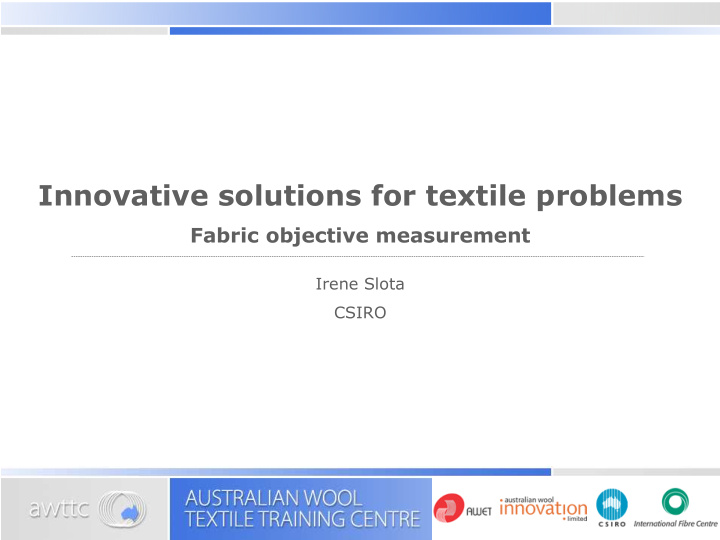



Innovative solutions for textile problems Fabric objective measurement Irene Slota CSIRO
The properties of fabrics Aesthetic: § handle § performance in garment manufacture § initial appearance - § § seam pucker § shape distortion appearance in wear - § § pilling § wrinkle recovery. Functional: § tear strength § tensile strength § abrasion resistance § water and oil repellence § flammability. §
So what’s the problem? § We need to predict: § performance § appearance. § Cost of fabric $50. § Cost of suit $1000. § It ’ s too late when the fabric has been cut.
The challenge To agree on the relevant descriptors § for fabric aesthetics and their subjective evaluation. To ascertain the appropriate § mechanical properties. To agree the conditions under which § they should be measured. To establish the necessary § correlations and/or descriptive algorithms between aesthetics, characteristics and fabric properties.
The opportunity § To measure objectively the handle of fabrics and use this measurement in trading of fabrics. § To predict performance in fabric manufacture and, therefore, avoid garments of poor appearance. § To correct potentially poorly performing fabrics before they are cut.
Historical context (pre-reading) 1930s Pierce – stiffness, § compressibility, friction and drape. 1960s Swedish workers – formability. § 1970s: § work of HESC Japan § release of the KES-F. § 1980s: § application of KES-F § development of SiroFAST. § 1990s: § release of SiroFAST § augmentation of SiroFAST § new instrumentation. §
Where is the innovation? Three forms of innovation are identified: § the innovation involved in deciding how best to measure aesthetic properties such as handle and the decision on the key characteristics or properties of fabrics that must be measured and relating them to the required fabric characteristics § the innovation involved in the development of instruments designed to measure those properties § the innovation involved in improving instrument design to minimise testing time and increase accuracy.
The HESC committee and KES-F instrumentation Japan 1960-70s Innovations: § agreement on subjective § description and scoring of handle agreement on key mechanical § measurement and construction of the instruments condensation of data § correlation with handle and § garment appearance measurement and prediction of § aesthetics.
Innovations in KESF-2B Bending Meter § Meter measures bending rigidity and hysteresis effects. § INNOVATION: § design of the movement of the jaw to ensure fabric remained in bending.
Innovations in KESF-4B Friction meter § Measure measures fabric friction an contour of surface. § INNOVATION: § duplicate fabric-finger friction.
Evolution of the KES-F system § SYSTEM – B. § Improved sample preparation procedures. § Reduced preparation times. § SYSTEM – AUTO. § Automated testing. § Reduced testing times.
Australia 1980s: AWTOMEC Recognition of the need for § greater simplicity in KES-F. Alternative use of data from § KES-F. Recommended simpler § concepts and alternative measurements from KESF-F instruments. Avoided calculation and/or § prediction of aesthetics. Relied on interpretation § using individual properties.
Other solutions § Simple instruments: § tensile tester § bending meter. § Ring and slot (Direct). § El Mogahzy-Kilinc (funnel). § Ramkumar artificial finger.
The development of SiroFAST Developed by CSIRO Textile and § Fibre Technology in Australia. Uses simple instruments to § measure fabric properties. Instruments much less expensive § than KES-F. Simpler to use. § More suited to a mill environment. § Gives detailed instructions for § interpretation of data and correction of fabrics.
Innovations in SiroFAST-1 Thickness Meter § Measures the thickness of the fabric before and after relaxation. § INNOVATIONS: § concept of surface thickness § use of proximity meter.
Innovations in SiroFAST-2 Bending Meter § Measures the bending length of fabric. § INNOVATIONS: § electronic eye § calibration tool. FAST-2 Detector Light Source Old Instrument
Innovations in SiroFAST-3 Extensibility Meter § Measures fabric extensibility in warp weft and bias direction. § INNOVATION: § use of balanced beam § use of proximity meter to measure deflection.
Innovations in SiroFAST-4 Dimensional Stability Test Measures relaxation shrinkage and hygral expansion. Manual measurement Use of a digitising tablet
Italy 1990s: the augmentation of SiroFAST § Recognition of the weaknesses of SiroFAST. § Standardised conditions for steam setting of the fibres.
Innovations in SiroFAST-PressTest
15-minute challenge § Design a tool to calibrate the angle of the light path. § The measurement of fabric movement.
One set of solutions
Adoption of fabric objective measurement China? Introduction of SiroFAST Use of simple Introduction Instruments of KES-F 2010 1930 1970
Summary - Innovation Innovative processes: § to recognise the problem § to standardise subject evaluations § to determine the required measurements § to design instruments to measure those § properties to simplify the use of those instruments § to recognise the remaining weaknesses § § AND START AGAIN.
Recommend
More recommend